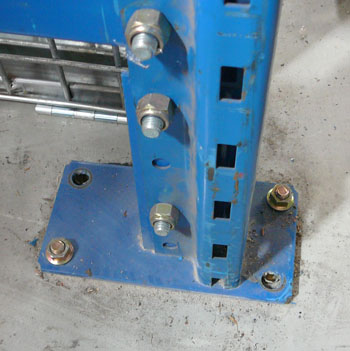
Many businesses have a need for pallet racking. Regardless of the amount of racking and its size, correctly installed racking is imperative to providing a safe working environment. The type of racking required when used as a storage medium depends on a number of factors such as desired pallet storage capacity, inventory rotation and storage design. Some types of pallet racks include: selective, drive-in, push back, and narrow aisle. Regardless of the type of racking needed for a specific application all racks must be anchored to a concrete floor for stability and security. Both the concrete floor and the fixings must be suitable for the pallet racking installed.
Once the correct type of pallet racking is determined for the application, a floor plan must be designed taking into consideration all aspects of the facility. The racking provider should supply the correct floor fixings for the application. The most commonly used option to secure pallet racking to a concrete floor is the dyna bolt or concrete wedge anchor. These fixings are available in a variety of diameters and lengths and are specifically designed for use in solid concrete. The diameter to be used in each application is dependent upon the size of the hole in the base plate of the upright.
Keep in mind, all of the racks should be level and plumb before installing any floor fixings. It is also essential to ensure that every upright of the pallet racking frame is adequately secured to the concrete floor when completed.
Step by Step Instructions
The installation of dyna bolts for pallet racking should be installed using the racking manufacturers guide lines that have been predetermined by qualified engineers.
The dyna bolts are normally installed using the following procedure. Using the holes in the base plate as a template, carefully drill holes using a hammer drill and masonry bit. The drill bit diameter should be the same diameter as the dyna bolt. Insert the dyna bolt into the hole, be sure to place the washer and thread the nut a couple of turns. Not fully threading the nut protects the threads of the wedge anchor. Insert the dyna bolt into each hole through the baseplate of the upright of the pallet racks. Carefully hammer the anchors into each hole ensuring that they are installed to the desired depth. Tighten all the nuts using a torque wrench to ensure they are tightened to the required torque value.
It is important to keep safety in mind and follow the pallet racking manufacturer’s instructions carefully. It is paramount that safety goggles are worn, handle all tools with extra care, and follow all technical specifications. This article is meant to serve as a basic overview of the steps for completing this project. Always refer to the manufacturer’s instructions or consult a qualified expert like Better Storage Systems in Brisbane, Australia when deciding on the pallet racking you require for your application.

